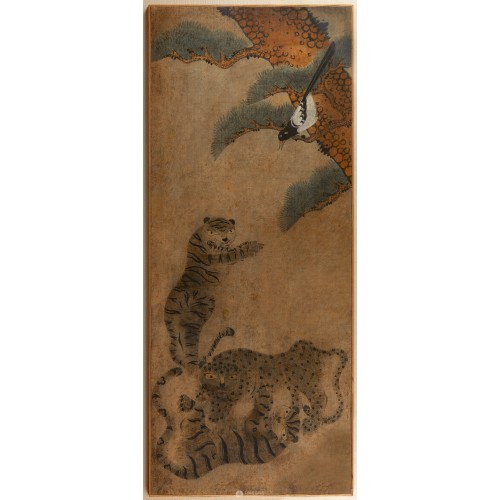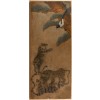본문
호작도(虎鵲圖)는 호랑이와 까치를 주된 소재로 한 대표적 민화로, 단순한 길상화를 넘어 민중의 정서와 해학, 그리고 상징이 어우러진 한국 고유의 회화 형식입니다.
원·명나라의 자모호도(子母虎圖)와 유호도(儒虎圖)를 기원으로 하며, 17세기 임진왜란 전후 조선에 전래되어 시간이 지나며 점차 한국적인 평면화된 양식으로 정착하였습니다.
호랑이는 권력층 혹은 산신령의 사자(使者)를, 까치는 민중 혹은 복을, 소나무는 장수와 절개를 상징합니다. 또한 호랑이는 사악한 기운을 막는 벽사의 의미도 지녀, 보호와 안녕을 기원하는 기능을 하기도 하였습니다.
초기에는 호랑이만 단독으로 그려졌으나, 이후 까치와 함께 등장하며 해학적 요소와 상징성이 더해집니다. 19세기에 이르러 점차 자유롭고 익살스러운 민화적 특성을 띠며 때로는 풍자적 의미도 내포하게 됩니다.
해당 유물의 도상에는 까치와 호랑이가 등장하며, 호랑이의 털 무늬는 점박이와 줄무늬가 혼합되어 있습니다. 익살스럽게 표현된 호랑이와 당당한 자세의 까치는 이 유물이 한국적으로 재해석되던 과도기의 예로 사료됩니다.
━━━━━
《虎鹊图》是以老虎与喜鹊为主要题材的代表性民画,不仅是传统吉祥画,更融合了民众情感、幽默趣味与象征意义,是独具特色的韩国绘画形式。
其源流可追溯至元、明时期的《子母虎图》与《儒虎图》,约于17世纪壬辰倭乱前后传入朝鲜,逐渐发展为具有韩国本土特色的平面化图像风格。
图中,老虎象征权力阶层或山神的使者,喜鹊象征百姓或福运,松树则象征长寿与节操。此外,老虎也具备驱邪避祸的辟邪意义,承载着祈愿平安的功能。
早期画面多以老虎单独出现,后期则增添喜鹊,赋予作品更多的象征与诙谐意味。至19世纪,画风趋于自由活泼,充满民画特有的趣味性,部分作品甚至带有讽刺意味。
此件作品中,喜鹊与老虎同现,虎身毛纹融合了斑点与条纹,表现手法诙谐而富有个性,喜鹊则姿态自若,象征性与民俗性兼具,可视为虎鹊图由传统向朝鲜本土样式转变过程中的代表性作品。
━━━━━
Hojakdo (虎鵲圖), featuring a tiger and a magpie, is a representative genre of Korean folk painting. Beyond a simple auspicious image, it blends humor, symbolism, and the sentiment of the common people, forming a uniquely Korean painting style.
It originates from the Jamohodo (子母虎圖, "mother-and-child tiger painting") and Yuhodo (儒虎圖, "Confucian tiger painting") of the Yuan and Ming dynasties and was introduced to Joseon around the time of the Imjin War in the 17th century. Over time, it evolved into a distinctively Korean, planar style.
In the composition, the tiger typically symbolizes authority or a messenger of mountain spirits; the magpie represents the people or blessings, while the pine tree signifies longevity and integrity. The tiger also functions as an apotropaic symbol, warding off evil spirits to ensure protection and peace.
Early versions featured the tiger alone, but later compositions included magpies, adding humorous and symbolic depth. By the 19th century, the genre developed more playful and witty characteristics, sometimes with satirical undertones.
This particular artifact depicts both a magpie and a tiger. The tiger’s fur shows a mix of spots and stripes, and its humorous expression contrasts with the magpie’s upright stance, exemplifying a transitional stage in the Korean reinterpretation of the genre.

